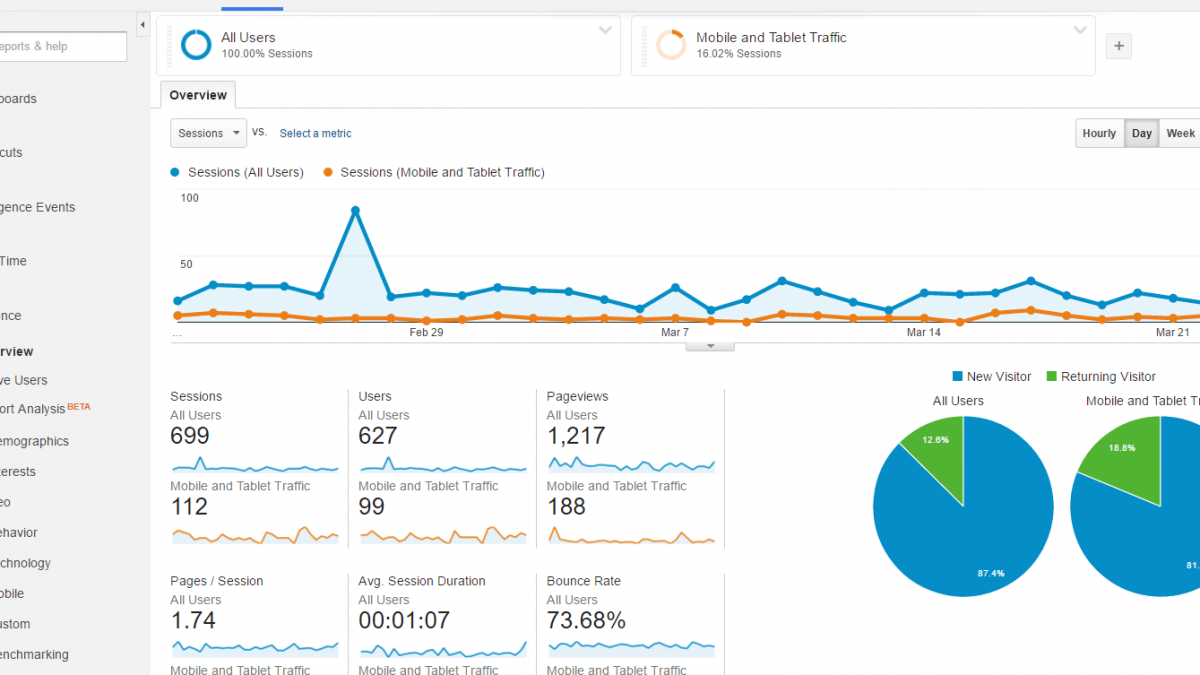Google Analytics
Google Analytics Overview
Catherine Blum writes an overview on Google Analytics and emphasizes how useful and important this tool is in the marketing industry. Google Analytics makes it easier to measure results and returns on investments.
If you’re an online marketing company or someone aspiring to be an online marketing manager then you should be familiar with Google Analytics. Known as an essential tool in the industry, everyone or every company trying to succeed in the competitive market of online marketing should know its ins and outs.
Google Analytics is responsible for providing statistics for websites, videos, apps, Facebook pages and more. And once you set up your Google Analytics account you can configure it to analyse more than one website at the same time. So if you’re an organisation with 10 websites you don’t have to set up 10 different accounts to track each one of them.
This post will introduce the main aspects of Google Analytics so you know what you’ll be dealing with (or at least so you’ll know what you’re missing out on). When you login to Google Analytics you’ll notice a left sidebar that looks like the image on the left. This gives you a brief idea of how many features Google Analytics has. In the dashboard there’s an overview of your website statistics. First thing you should know is that the dashboard displays information of the last 30 days but in case you want to analyse other periods you can easily change the settings by clicking on the date displayed on the top right of the dashboard. You can also compare periods thus it’s easier to see your website progress. In the standard dashboard it’s possible to check the number of new visits and unique visitors, location of visitor, which browser they’re using, the bounce-rate (when people exit the website through the landing page without actually interacting with any other page), how long visitors are spending in your website (average visit duration), the revenue (if you have an e-commerce) and you goal completions, but you can customise the dashboard and set it to show only the information that are more important to you. In fact that’s one of the great things about Google Analytics: it’s customisable. Besides the dashboard you can also customise your reports so you’ll have easy access to your essential data. In addition, Google Analytics allows users to export data to several different formats, including excel and PDF, as well as e-mail it straight from the dashboard.
As the name suggests, Shortcuts permit users to create shortcuts that keep saved settings of a report they need to access frequently, whilst Intelligent Events shows alerts when a specific metric performs differently from what was expected. And Intelligent Events is another customisable feature in Google Analytics. There are two types of alerts: the ones that Google Analytics identify unusual activity in a metric or a custom alert in which the user defines when to be warned when a specific metric behaves unexpectedly.
Real-Time reports show updated information on how many users are on the website at that moment, where they’re from and what content they’re looking at. It’s a great feature for those working with social media as you can see public response right away.
Audience might be the most known and used feature of Google Analytics. Knowing your visitors can help you adjust your campaign to ensure maximum return. In Audience you get information on you visitors demographics (age and gender), interests, geolocation (language and location), behaviour (how many new/old visitors, how often they visit the website and how they interact with the pages), the technology (browsers) and mobile devices they’re using. It’s also possible to see the visitor’s flow in the website which means you can check their track, which pages they navigate on including landing pages and drop-offs.
The tab Acquisition is all about understanding the traffic your website is getting: where your visitors come from, if from a search or a referral website for example, how many pages they access per visit, how long are the visits, as well as the bounce rate. Within this tab you’ll find a Search Engine Optimisation (SEO) feature which is only available after you connect your website to the Webmaster Tools. In this feature you can find out what keywords your visitors are using to find you, which is a vital element for a successful SEO project.
Behaviour reports are about the website speed, the effectiveness of the search box in your website and more. In Conversions you can set up goals to monitor your website and pages progress as well as track your online store performance (if you have one of course).
This short overview doesn’t cover all the potential and benefits Google Analytics could bring to your business. There’s much more to be absorbed from this service and it can be done by accessing Google Analytics Academy in which you can do a course on the subject and learn how to use and understand all the features. For more information visit: https://analytics.google.com/analytics/academy/
Related Posts
Categories
- Corporate SEO (34)
- Corporate SEO Company (18)
- Corporate Videos (1)
- Enterprise Social Networking (1)
- Fashion SEO (7)
- Featured (22)
- Inspiration (1)
- Medical SEO (8)
- Offsite SEO (12)
- Prestige Brand SEO (21)
- Search Engine Optimisation (31)
- SEO Articles (35)
- SEO Australia (26)
- SEO Case Studies (20)
- SEO Sydney (19)
- SEO Sydney Clients (18)
- Social Media (8)
- Style (3)
- Tips & tricks (8)
SEO Client Testimonials
"When we started with Stewart and his team in 2011 we had one website and a small clinic in Artarmon. Now we've moved to massive premises in the centre of Chatswood, thanks to the influx of patients from our 4 new websites." Emma Boulton, Clinic 66.
"Our lives have gone forward dramatically since we got involved with the Corporate SEO Company. We've had media interest from all the major newspapers, won awards, and got our chai product not just into Coles and Woolies, but a stack of new countries." Martin Buggy, Bondi Chai.





